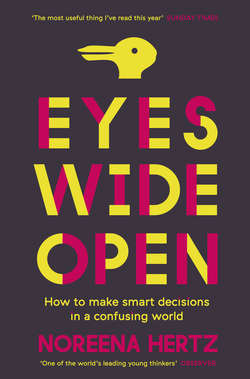Читать книгу Eyes Wide Open: How to Make Smart Decisions in a Confusing World - Noreena Hertz - Страница 9
Drowning in the Deluge
ОглавлениеFor this is the age of data deluge.
An age in which advertisers, marketers and media outlets tweet us, text us, and follow us online. An age of Facebook News Feeds and Amazon Recommends. An age in which we are overwhelmed with information, increasingly to breaking point.
A New York Times Weekly Edition contains more information than the average person in the seventeenth century was likely to come across in their entire lifetime.3 In 2008 we were consuming three times as much information as we were in 1960.4 By 2020 we’ll be generating forty-four times more data than we are producing today.5
Our stone-age bodies can’t cope with this modern-day deluge. Evolution is slow; the deluge has come fast. Confronted with data – some dodgy, some not – our hearts beat faster, our breath becomes more shallow, we sweat: the deluge makes our body shift into crisis mode.6
Studies reveal that we can’t hold more than seven separate pieces of information in our minds at once.7 Yet when I enter ‘Qualities to look for in a surgeon?’ into Google, four million hits come up. The sheer abundance overwhelms us. That’s why most of us end up looking at just the first few links on the first page of Google’s search results.8 The best answer to our query might not be there, but we can’t cope with more.
How can we find the space to think clearly, with all of this data raining down on us? How can we discern intelligence from all this noise?
For there is intelligence amidst the cacophony. In fact, the data deluge has a notable upside: we can now get our information raw, unedited, uncurated. We can now imbibe information direct from source, without the traditional gatekeepers.
This offers a huge opportunity to us as decision-makers. But the question of what, among all the data swirling around the digital landscape, we should give credence to is not straightforward to answer.
In London in August 2011, huge numbers of people rioted, and parts of the city went up in flames. Shops were emptied of expensive trainers and wide-screen TVs. The police looked on powerlessly.
It wasn’t that there was no information. Tuned in to social media, police command centres were overwhelmed by the 2.6 million riot-related tweets that circulated during the five days of rioting.9
The tales circulating the Twittersphere were plentiful and varied – from the political to something more akin to a child’s picture-book: rioters breaking into a branch of McDonald’s to cook their own food, the London Eye being set on fire, a tiger being set free from London Zoo.
The problem was, in the face of so much information, how could the police work out which stories to trust and which to reject? Which leads should manpower be assigned to investigate? Which should be ignored?
All of those tweets mentioned above turned out to be false, by the way.
In the age of data deluge, with information so fractured and diffuse, and arising from so many disparate sources, how do we know what to believe and what to reject, so we are able to benefit from the digital dividend? That is a challenge that this book will address.
